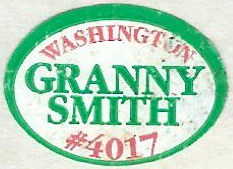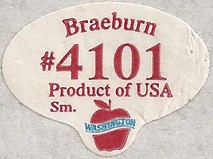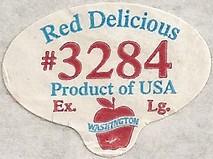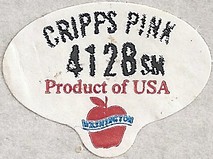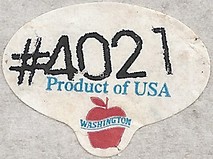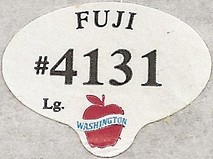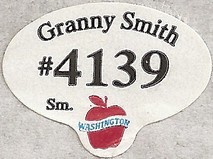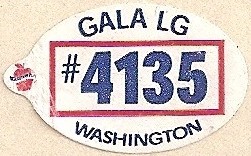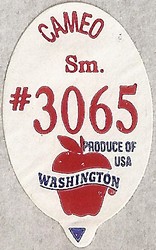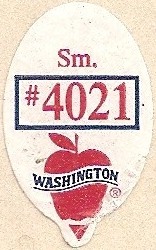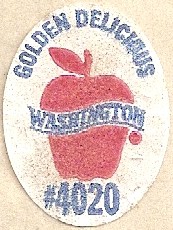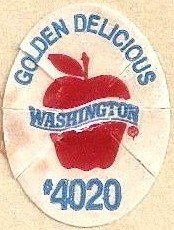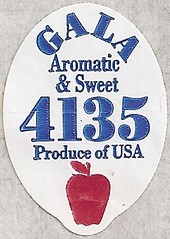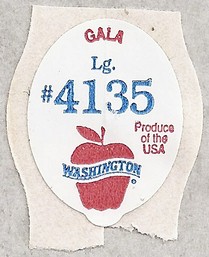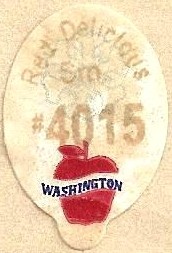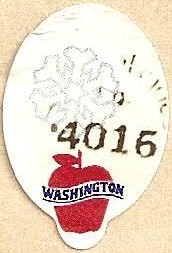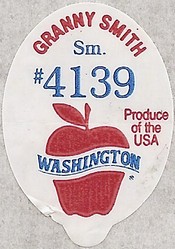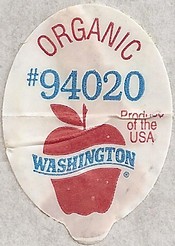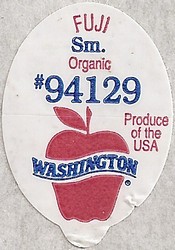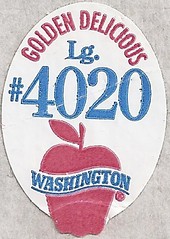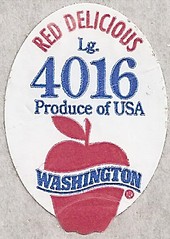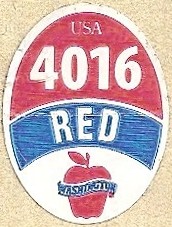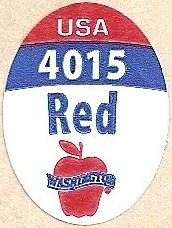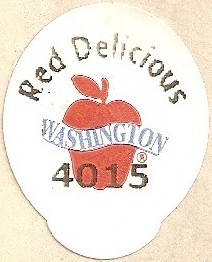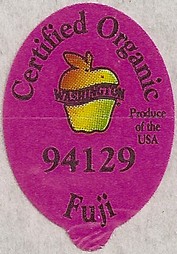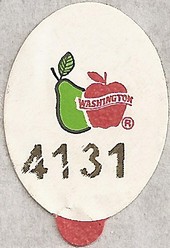Labelmania
Apples-Big series
Trade name: Washington Apple Commission
Washington Apple Commission Origin
 The Washington State Apple Advertising Commission was created by an act of the Washington State Legislature in 1937 at the request of the apple industry, making it one of the oldest and largest commodity commissions in the United States.
The Washington State Apple Advertising Commission was created by an act of the Washington State Legislature in 1937 at the request of the apple industry, making it one of the oldest and largest commodity commissions in the United States.
The Commission is considered a governmental agency since it is state-mandated, yet is governed and totally funded by growers under the supervision of the Director of Agriculture who approves the budget and sits on the Board of Directors.
The primary purpose of the Commission is advertising, promotion, education and market development for the Washington fresh apple crop. Currently no promotions are being implemented in the US, but are implemented in more than 30 countries overseas where Washington apples are sold. In the fertile valleys and plateaus of America's Pacific Northwest, growers tend orchards that produce the world's best apples. More than 175,000 acres of apple orchards are nestled in the eastern foothills of the picturesque Cascade Mountains of Washington at elevations from 500 to 3,000 feet above sea level. The orchards are irrigated with plentiful and cool mountain water.
The area first became known to American pioneers at the turn of the 19th century and by 1826, early settlers had discovered that the area's rich lava-ash soil and plentiful sunshine created the ideal conditions for growing apples. The arid climate also meant fewer insect and disease problems, thereby increasing the overall pristine quality of the apples through to harvest. Noting the health and vigor of apple trees planted along stream banks, pioneers developed irrigation systems, and by 1889, commercial orchards were established. Most apple-growing districts in the State are still located along the banks of major rivers.
The average size of a Washington Apple orchard is about 100 acres, but some cover as many as 5,000 acres and employ 300 or more farm workers year-round. It takes an estimated 35,000 to 45,000 pickers to harvest the apple crop during the peak of harvest. Washington State growers successfully harvest a wide variety of apples including Red and Golden Delicious, Granny Smith, Braeburn, Honeycrisp, Fuji, Gala and many others.
Link to: corporate website, Facebook, Wikipedia. A beautiful collection of Apple Box Labels images (Crate labels).
 The Washington State Apple Advertising Commission was created by an act of the Washington State Legislature in 1937 at the request of the apple industry, making it one of the oldest and largest commodity commissions in the United States.
The Washington State Apple Advertising Commission was created by an act of the Washington State Legislature in 1937 at the request of the apple industry, making it one of the oldest and largest commodity commissions in the United States.The Commission is considered a governmental agency since it is state-mandated, yet is governed and totally funded by growers under the supervision of the Director of Agriculture who approves the budget and sits on the Board of Directors.
The primary purpose of the Commission is advertising, promotion, education and market development for the Washington fresh apple crop. Currently no promotions are being implemented in the US, but are implemented in more than 30 countries overseas where Washington apples are sold. In the fertile valleys and plateaus of America's Pacific Northwest, growers tend orchards that produce the world's best apples. More than 175,000 acres of apple orchards are nestled in the eastern foothills of the picturesque Cascade Mountains of Washington at elevations from 500 to 3,000 feet above sea level. The orchards are irrigated with plentiful and cool mountain water.
The area first became known to American pioneers at the turn of the 19th century and by 1826, early settlers had discovered that the area's rich lava-ash soil and plentiful sunshine created the ideal conditions for growing apples. The arid climate also meant fewer insect and disease problems, thereby increasing the overall pristine quality of the apples through to harvest. Noting the health and vigor of apple trees planted along stream banks, pioneers developed irrigation systems, and by 1889, commercial orchards were established. Most apple-growing districts in the State are still located along the banks of major rivers.
The average size of a Washington Apple orchard is about 100 acres, but some cover as many as 5,000 acres and employ 300 or more farm workers year-round. It takes an estimated 35,000 to 45,000 pickers to harvest the apple crop during the peak of harvest. Washington State growers successfully harvest a wide variety of apples including Red and Golden Delicious, Granny Smith, Braeburn, Honeycrisp, Fuji, Gala and many others.
Link to: corporate website, Facebook, Wikipedia. A beautiful collection of Apple Box Labels images (Crate labels).
Due to the large number of labels the series were divided into 4 groups and therefore 4 pages:
Only Washington

cv.name and plu

cv.name and plu
Only Washington - Analytical key
- Very old labels w/o logo only text "Washington"
- Thin plastic with vrinkle = series 01
- Paper with 6 cuts w/o tab = series 02
- Paper with 6 cuts with tab = series 02A
- Paper w/o cuts= series 03
- Horizontal labels
- With apple logo in down tab
- Produce of USA, cv.name and plu typographic printed = series 04
- Produce of USA, cv.name and plu overprinted = series 05
- W/o origin = series 06
- With apple logo in left tab = series 07
- With white tab at right = series 08
- Vertical labels with arrow in down tab
- Little apple (5-6 mm hight, only apple)
- Cv.name red
- W/o origin = series 09
- Produce of USA = series 10
- Cv.name blue
- W/o origin, plu w/o rectangle = series 11
- W/o origin, plu into a rectangle = series 12
- Produce of USA = series 13
- Medium apple (7 mm) = series 14
- Big apple (8-9 mm)
- Cv.name blue (not organic) = series 15
- Cv.name red (not organic)
- Plu with # = series 16
- Plu w/o # = series 17
- Organic = series 18
- Big pear = series 18a
- Vertical labels w/o arrow
- Labels with only red and blue colours or rarely 3 colors
- Labels W/o tab
- Produce of USA = series 19
- Only USA = series 20
- W/o origin = series 21
- Old label w/o origin, big apple = series 21A
- Labels with white tab and apple high 4,5 mm
- Apple with Washington = series 22
- Apple w/o Washington = series 23
- Labels with white tab and apple high 5,5-6 mm = series 24 and 24A
- Labels with white tab and apple high 7,5 mm
- W/o origin = series 25
- Produce of USA (not organic) = series 26
- Produce of USA organic = series 27
- Labels with apple into tab that is trilobed
- W/o origin
- Big apple 7 mm high, green text, bio = series 28a
- Big apple 8 mm high = series 28
- Big apple 9 mm high = series 29
- Produce of USA
- Big apple 9 mm high, red "Produce of USA" = series 29
- Smaller apple, blue "Produce of USA" = series 29
- Small plu # (not organic) = series 30
- Big plu # (not organic)= series 31
- Big plu # organic = series 32
- Divers
- Oval horizontal = series 33
- Oval vertical = series 34
- Labels with more colours
- 1 fruit: apple
- White bkg = series 35
- Pink bkg = series 36
- Crimson bkg = series 37
- 2 fruits: apple and pear = series 38
For unusual colours name and shades see here








